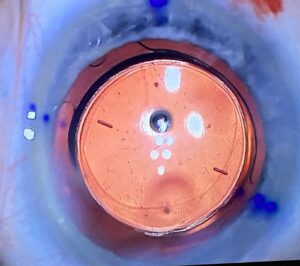An enhanced monofocal IOL delivering up to 1.5 D of high quality vision.
Discover how RayOne EMV and RayOne EMV Toric can fit into your premium IOL offering
Centre region
Induced positive spherical aberration


Blended edge region
Reduced longitudinal spherical aberration designed to maintain visual acuity and constrast sensitivity under mesopic conditions.

The patented RayOne EMV optic maintains monofocal-quality distance vision
RayOne EMV uniquely redirects light BOTH myopically to extend depth of focus for excellent intermediate vision AND hyperopically for a wider landing zone
This unique hyperopic extended depth design also provides enhanced blended binocular vision when used in a monovision configuration
Proven rotational stability and centration8 with predictable, sustainable and accurate visual results

Comparative outcomes with RayOne EMV
At the Hospital da Luz Lisboa in Lisbon, Professor Filomena Ribeiro and Professor Tiago Ferreira led a 150 patient double-arm, non-randomised prospective case series where RayOne EMV demonstrated excellent visual outcomes for distance and intermediate vision, and good visual acuity for near vision.1
RayOne EMV versus TECNIS Eyhance
At the Hospital San Rafael in Madrid, 22 eyes of 11 patients were implanted with RayOne EMV and 70 eyes of 35 patients implanted with TECNIS Eyhance (Johnson & Johnson Vision). Bilateral emmetropia was targeted for all patients. The defocus curve reports the binocular vision obtained using the best distance correction.6
Monovision outcomes with RayOne EMV
At the Tan Tock Seng Hospital in Singapore, Dr Tun Kuan Yeo demonstrated the binocular impact of positive spherical aberration by combining RayOne EMV with 1.5 D of monovision. The study showed similar performance for both photopic and mesopic conditions.
Results from a multicentre evaluation involving 16 surgeons across eight countries and 56 patients (89 eyes) show that RayOne EMV Toric offers:


Rayner and RayOne are proprietary marks of Rayner. All other trademarks are property of their respective owners.